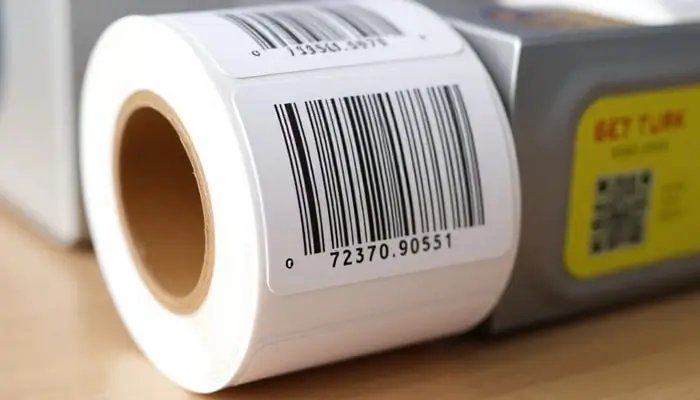Karcode / Barcode Label Dimensions

Barcode Label Dimensions
qr_codeBarcode Label Design ToolBarcode label dimensions refer to the dimensions of the labels on which barcodes are placed for product identification and inventory management. It's crucial that they are appropriate for their intended use and scanner-friendly.
The Importance of Barcode Label Dimensions
The correct size barcode label directly impacts readability, ease of installation, and efficiency. Choosing the wrong size can lead to scanning errors, increased costs, and operational disruptions.
Readability and Material Balance
Barcodes that are too small can cause jammed lines and scanner errors, while labels that are too large take up unnecessary space and increase costs.
Global Standard Sizes Table
Below are the barcode sizes and descriptions commonly used around the world:
| Standard / Region | Barcode Type | Recommended Dimensions (mm) | Explanation |
|---|---|---|---|
| GS1 (EAN-13 Nominal) | EAN-13 | 38 × 25 | Nominal size, global retail standard |
| GS1 (EAN-13 Min. 80%) | EAN-13 | 25.1 × 18.3 | Minimum valid size (80%) |
| North America United Kingdom | UPC-A | 37.3 × 25.9 | Common retail standard |
| EAN-8 / Small Products | EAN-8 | 16.8 × 22.9 | Ideal for small packages |
| PDF417 | 2D Stacked | ~38 × ~10 (stack variable) | Size varies by user according to ISO/IEC standard |
| Code 128 (min.) | Linear | 31.75 × 12.7 (1.25″ × 0.5″) | A small but readable rectangle |
Local Standard Sizes Table
Barcode label dimensions and usage areas commonly used in Türkiye and similar markets:
| Label Size (mm) | Area of Use | Explanation |
|---|---|---|
| 20 × 30 | Cosmetics, small items | Suitable for use in narrow spaces. |
| 25×40 | Textiles, small packaging | Standard EAN-13 and Code 128 compliance. |
| 30 × 50 | Retail, e-commerce | Medium size, popular choice. |
| 40 × 60 | Cargo, logistics | Address and barcode in one field. |
| 50 × 70 | Warehouse, shelf addressing | Large barcode, readable from a distance. |
| 60 × 100 | Pallet / industrial | Large data area, easy browsing. |
Global Factors to Consider When Selecting a Barcode Label
Whether local or global, some universal criteria should be taken into consideration when making a selection.
Compliance with Standards
Barcodes such as EAN-13, UPC-A, and EAN-8 must conform to GS1-defined dimensions. 2D barcodes such as QR codes and PDF417 must be designed according to ISO/IEC standards.
Barcode Type and Size Compatibility
While linear barcodes require more horizontal space, 2D barcodes (QR, PDF417) can carry more data in a smaller space. Size recommendations vary by barcode type.
Reading Distance and Content Amount
Large area and barcode height are important for logistics labels that need to be read from a distance; smaller but clear codes are preferred for retail products.
Conclusion: How to Achieve Global and Local Harmony
Blending local needs with global standards yields the best results. EAN-8 (≈16.8 × 22.9 mm) is ideal for small products, EAN-13 (≈38 × 25 mm) for retail, and 30 × 50 mm is sufficient for general use in the domestic market. Choosing the appropriate size based on the barcode type on the line ensures both compatibility and efficiency.
Material and Printing Types in Barcode Labels
The material and print type used, as well as the size of barcode labels, are important for longevity and readability. Label selection should take into consideration the product's storage conditions, external factors, and lifespan.
Paper Labels
Paper labels are the most common type and are suitable for most retail products. They can be printed with thermal or inkjet printers. They are ideal for short-lived products and are cost-effective.
Synthetic Labels (PP, PE, PVC)
Synthetic labels are more durable and resistant to contact with moisture, water, or chemicals. They are recommended for long-term use, outdoor use, and logistics processes. Their durability increases when used with thermal transfer printing.
Thermal and Thermal Transfer Printing
Thermal printing is used for short-term applications and doesn't require a ribbon. Thermal transfer printing, on the other hand, works with a ribbon, ensuring long-lasting label life. Thermal transfer is generally preferred for industrial products and warehouse labels.
2D Barcodes and Global Measures
With the ever-increasing need for data, 2D barcodes (QR, Data Matrix, PDF417) have gained importance in terms of global measurements. These barcodes provide high data density while taking up less space and are easily scannable by mobile devices.
| Barcode Type | Recommended Size (mm) | Area of Use |
|---|---|---|
| QR Code | 15 × 15 – 50 × 50 | Product packaging, marketing materials, e-commerce packages |
| Data Matrix | 10 × 10 – 40 × 40 | Global standard for pharmaceuticals, electronics and small products |
| PDF417 | 38 × 10 – 50 × 25 | ID cards, logistics and transport labels |
Barcode Placement and Optimization Tips
Proper barcode placement is just as important as label size and material. Incorrect placement can lead to scanning issues and operational disruptions.
Compatibility with Product Surface
The barcode must be placed on a flat surface of the packaging. Folded edges, seams, or wrinkled labels make scanning difficult.
Void Area
Adequate space should be left around the barcode. This allows the scanner to separate the barcode from its surroundings and read it accurately. A minimum of 2–3 mm is recommended for small products and 5 mm for large barcodes.
Direction of the Barcode
Barcodes should generally be placed horizontally. Vertical placement can increase error rates in some scanners. Horizontal, fixed-position labels should be preferred in logistics applications.